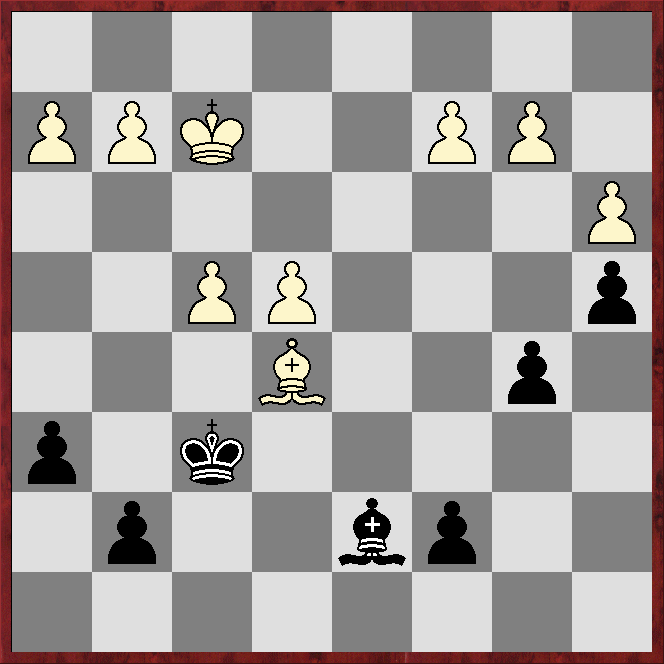I WROTE, but did not post, this article during the covid panic.
IN this series I am looking at the statistically best way to play against popular opening lines.
The numbers are drawn from the 2021 edition of ChessBase's Mega database, ignoring, where possible, those results that include very few games and so are statistically insignificant.
The Sicilian with 2...e6: 1.e4 c5 2.Nf3 e6 is sometimes called the safest Sicilian.
White's most popular reply, 3.d4, scores only 50%, as does the second-most popular reply, 3.c3.
Most successful, statistically, is 3.g3!?, which scores 54%.
 |
| Position after 3.g3!? |
There are four black moves appearing more than 200 times in Mega21.
A) 3...Nc6 (3,607 games)
After 4.Bg2 the line splits.
A1 4...Nf6 5.Qe2, after which the line splits again.
A1.1 5...d5 6.d3 Be7 7.0-0, when A1.1a 7...0-0 8.e5 Nd7 9.c4!? scores 66% for White, A1.1b 7...b6 8.e5 Nd7 9.c4!? scores 63% for White, and A1.1c 7...b5 8.exd5 exd5 9.d4!? scores 63% for White, albeit from a small sample.
A1.2 5...d6 6.c3!? Be7 7.0-0, when A1.2a 7...0-0 8.d4 cxd4 9.cxd4 d5 10. e5 Ne4 11.Be3!? scores 68% for White, and A1.2b 7...e5!? 8.d3 0-0 9.Nbd2 scores 74% for White, albeit from a small sample.
A1.3 5...e5!? 6.d3!? Be7 7.c3 0-0 8.0-0, when A1.3a 8...Re8 9.Na3 h6 10.Nc4 Bf8!? 11.Re1 scores 64% for White, albeit from a small sample, A1.3b 8...h6 9.Na3 Re8 is a transposition to A1.3a, and A1.3c 8...d6 is a transposition to A1.2b.
A1.4 5...Be7 6.d3, when A1.4a 6...0-0 7.0-0 d5 is a transposition to A1.1a, and A1.4b 6...d5 is a transposition to A1.1.
A2 4...d5 5.exd5 exd5 6.0-0 Nf6 7.Re1+ Be7 8.d4 scores 67% for White, albeit from a small sample.
A3 4...d6 5.d4!? cxd4 6.Nxd4, after which the line splits again.
A3.1 6...Bd7 7.0-0 Nf6 8.c4!? scores 59% for White, albeit from a small sample.
A3.2 6...a6 7.0-0 Bd7 8.Nc3, when A3.2a 8...Nf6 9.Nde2!? Be7 10.h3 scores 58% for White, and A3.2b 8...Be7 9.Nb3!? scores 62% for White, albeit from a small sample.
A4 4...g6?! (there are 348 examples of this move in Mega21, but it is probably a mistake) 5.d4 cxd4 6.Nxd4, after which the line splits again.
A4.1 6...Bg7 7.Nb5 scores 87% for White.
A4.2 6...a6 7.Nxc6!?, when A4.2a 7...dxc6 8.Qxd8+ Kxd8 9.e5 scores 80% for White, albeit from a small sample, and A4.2b 7...bxc6 8.0-0 Bg7 9.Na3!? scores 100% for White, albeit from a very small sample.
A4.3 6...Qb6 7.Nb3 Bg7 8.Nc3 scores 100% for White, albeit from a small sample.
B) 3...d5 (828 games)
After 4.exd5 exd5 5.d4 the line splits.
B1 5...Nc6 6.Bg2, after which the line splits again.
B1.1 6...Bg4 7.0-0!?, when B1.1a 7...cxd4 8.Re1+ Be7 9.Nbd2 Nf6 10.Nb3 scores 79% for White, albeit from a small sample, and B1.1b 7...Nxd4 8.Qe1+ Be7 9.Nxd4 cxd4 10.Qe5 Nf6 11.Qxd4 scores 57% for White.
B1.2 6...Nf6 7.0-0, when B1.2a 7...Be7 8.Be3 scores 66% for White, albeit from a small sample, and B1.2b 7...cxd4 8.Nxd4 Be7 9.c4 0-0 10.Nc3 scores 70% for White, albeit from a small sample.
B2 5...Nf6 6.Bg2 Be7 7.dxc5!?, after which the line splits again.
B2.1 7...0-0 8.0-0 Bxc5 9.Nc3, when B2.1a 9...Nc6 10.a3!? scores 65% for White, and B2.1b 9...h6 10.a3!? scores 85% for White, albeit from a small sample.
B2.2 7...Bxc5 8.0-0 0-0 is a transposition to B2.1.
C) 3...b6 (263 games)
After 4.Bg2 Bb7 5.d4!? the line splits.
C1 5...Bxe4 6.Nc3 Bb7 7.d5 scores 83% for White, albeit from a very small sample.
C2 5...cxd4 6.Nxd4 Nf6 7.Nc3 scores 64% for White, albeit from a small sample.
D) 3...a6 (221 games)
After 4.Bg2 the line splits.
D1 4...b5 5.d4!? cxd4 6.Nxd4 Bb7 7.0-0, after which the line splits again.
D1.1 7...Qc7 8.a4 b4 9.c3 scores 80% for White, albeit from a small sample.
D1.2 7...Nf6 8.Re1, when D1.2a 8...Qc7 9.Nc3 d6 10.a4 bxa4 11.Nd5!? exd5 12. exd5+ Kd8 13.Bg5 scores 82% for White, and D1.2b 8...d6 9.a4 b4 10.c3 scores 83% for White, albeit from a small sample.
D2 4...Nc6 5.d4!? cxd4 6.Nxd4, after which the line splits again.
D2.1 6...Qc7 7.Be3!? Nf6 8.0-0 Be7 9.c4!? scores 65% for White, albeit from a small sample.
D2.2 6...Nf6 7.0-0 Qc7 8.Be3!? is a transposition to D2.1.











